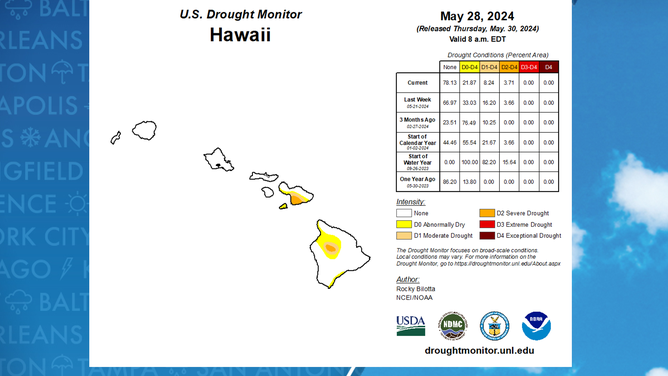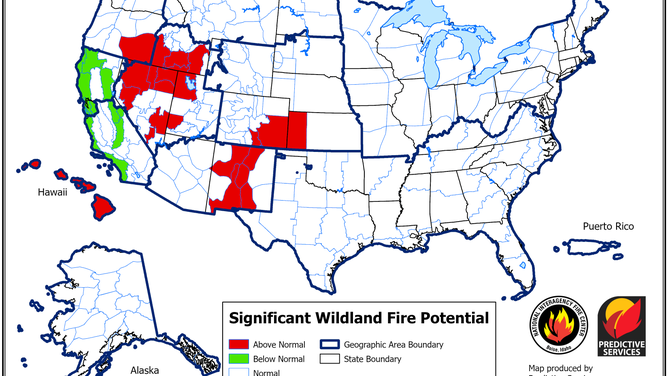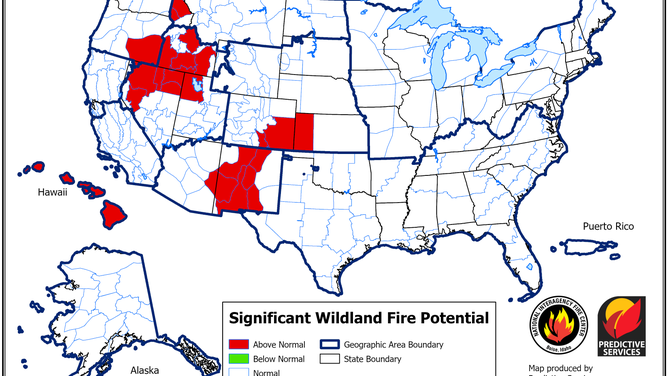Hawaii braces for extreme wildfire potential one year after devastating Lahaina fire
In August of 2023, wind-driven fires erupted across Hawaii. Local authorities reported a tragic loss, with at least 101 lives claimed in and around the town of Lahaina. These wildfires were fueled by a significant pressure gradient, with a ridge of high pressure to the north and the presence of Hurricane Dora to the south.
Is Hawaii primed for another Maui wildfire?
FOX Weather looks at drought conditions across the Hawaiian Islands which could result in another deadly wildfire like the ones last year across Maui and Lahaina.
HONOLULU – Hawaii could be facing another significant wildfire season, just a year after enduring the worst natural disaster in its history.
The National Interagency Coordination Center warns of significant fire potential persisting throughout the Hawaiian Islands into the fall, particularly on the leeward sides of mountains, where wildfires could rapidly spread.
The islands are vulnerable to flash droughts due to rapid evapotranspiration, where moisture escapes the ground and plants.
According to the U.S. Drought Monitor, only 8% of the islands are officially in drought status, which is higher than last summer.
In just three months of 2023, the drought status escalated from 0% to over 80% of communities experiencing some type of dryness.
The rapid drying out of vegetation and soil was reported to be one of many factors in the lead up to wildfires in 2023.
The series of wind-driven fires ravaged several islands, killing at least 101 people in and around Lahaina and destroyed more than 2,000 structures.

Hawaii drought monitor
(FOX Weather)
FIFTH-GENERATION HAWAIIAN LOSES HOME IN LAHAINA WILDFIRE
The NICC’s fire potential outlook singled out the Hawaiian Islands, alongside the Pacific Northwest and northern Rockies, as regions facing heightened wildfire risks through the summer and possibly beyond.
For the 137 islands that make up the archipelago, forecasters said a combination of the annual dry season and a change in the status of the El Niño-Southern Oscillation will likely lead to an increase in fire potential.
"Rainfall tends to be above average for most of the El Niño year. Dry conditions tend to start by the end of the El Niño year and are at their worst during the first half of the year after El Niño. In some cases, dry conditions can persist for the entire year after El Niño," the islands’ National Weather Service previously stated about the phenomenon.
A wet spring has increased the amount of fuel available for fires, with wildfire activity expected to peak in August and September.
NOAA EXPECTS BELOW-NORMAL HURRICANE SEASON IN CENTRAL PACIFIC
Unknowns going into the heart of the fire season
While fire activity is expected to be above normal, there are elements of the perfect storm scenario that unfolded in 2023, which have a remote chance of happening again.
Last year’s wind-driven wildfires were courtesy of a significant pressure gradient, with a ridge of high pressure to the north of the islands and a major hurricane named Dora to the south.
These weather elements were significant in strength and were part of a synoptic set-up that doesn’t happen regularly.
In 2024, the number of hurricanes bypassing the islands is expected to be reduced as NOAA has predicted below-average hurricane activity in the central Pacific due to an approaching La Niña.
Another unknown is how local emergency management will respond to the next disaster.
The islands’ agencies have not faced a disaster as complex as the August 2023 wildfires, so adjustments made to protocols have not been tested and, in some cases, implemented.
The Maui Emergency Management Agency received widespread criticism in the days following the deadly Lahaina fire for its response and even saw its administrator resign.
A recently released 84-page report by firefighters sheds light on the challenges and offered dozens of recommendations, but missing from the report is any sort of timeline for when changes could occur.
Additionally, Hawaiian Electric says it is planning to preemptively shut off electricity in high fire-risk areas to prevent any type of ignition, unlike what happened in 2023.
More than 48,000 customers could see their power shut off as part of the company’s wildfire safety strategy during expected threats.
Power companies across the western U.S. have long adopted similar policies, but they aren’t foolproof in preventing fires.
Maui reopens to tourists after devastating wildfires
Ilihia Gionson, Public Affairs Officer with the Hawaiʻi Tourism Authority, explains what this reopening means for the island of Maui. Oct. 6, 2023.



